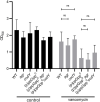Small Alarmone Synthetases RelP and RelQ of Staphylococcus aureus Are Involved in Biofilm Formation and Maintenance Under Cell Wall Stress Conditions
- PMID: 33072039
- PMCID: PMC7533549
- DOI: 10.3389/fmicb.2020.575882
Small Alarmone Synthetases RelP and RelQ of Staphylococcus aureus Are Involved in Biofilm Formation and Maintenance Under Cell Wall Stress Conditions
Abstract
The stringent response is characterized by the synthesis of the alarmone (p)ppGpp. The phenotypic consequences resulting from (p)ppGpp accumulation vary among species, and for several pathogenic bacteria, it has been shown that the activation of the stringent response strongly affects biofilm formation and maintenance. In Staphylococcus aureus, (p)ppGpp can be synthesized by the RelA/SpoT homolog Rel upon amino acid deprivation or by the two small alarmone synthetases RelP and RelQ under cell wall stress. We found that relP and relQ increase biofilm formation under cell wall stress conditions induced by a subinhibitory vancomycin concentration. However, the effect of (p)ppGpp on biofilm formation is independent of the regulators CodY and Agr. Biofilms formed by the strain HG001 or its (p)ppGpp-defective mutants are mainly composed of extracellular DNA and proteins. Furthermore, the induction of the RelPQ-mediated stringent response contributes to biofilm-related antibiotic tolerance. The proposed (p)ppGpp-inhibiting peptide DJK-5 shows bactericidal and biofilm-inhibitory activity. However, a non-(p)ppGpp-producing strain is even more vulnerable to DJK-5. This strongly argues against the assumption that DJK-5 acts via (p)ppGpp inhibition. In summary, RelP and RelQ play a major role in biofilm formation and maintenance under cell wall stress conditions.
Keywords: (p)ppGpp; Staphylococcus aureus; biofilm; cell wall stress; stringent response.
Copyright © 2020 Salzer, Keinhörster, Kästle, Kästle and Wolz.
Figures






Similar articles
-
Role of (p)ppGpp in antibiotic resistance, tolerance, persistence and survival in Firmicutes.Microlife. 2023 Mar 11;4:uqad009. doi: 10.1093/femsml/uqad009. eCollection 2023. Microlife. 2023. PMID: 37223729 Free PMC article. Review.
-
The Ps and Qs of alarmone synthesis in Staphylococcus aureus.PLoS One. 2019 Oct 15;14(10):e0213630. doi: 10.1371/journal.pone.0213630. eCollection 2019. PLoS One. 2019. PMID: 31613897 Free PMC article.
-
Two small (p)ppGpp synthases in Staphylococcus aureus mediate tolerance against cell envelope stress conditions.J Bacteriol. 2014 Feb;196(4):894-902. doi: 10.1128/JB.01201-13. Epub 2013 Dec 13. J Bacteriol. 2014. PMID: 24336937 Free PMC article.
-
Inducible expression of (pp)pGpp synthetases in Staphylococcus aureus is associated with activation of stress response genes.PLoS Genet. 2020 Dec 30;16(12):e1009282. doi: 10.1371/journal.pgen.1009282. eCollection 2020 Dec. PLoS Genet. 2020. PMID: 33378356 Free PMC article.
-
Pleiotropic Effects of Bacterial Small Alarmone Synthetases: Underscoring the Dual-Domain Small Alarmone Synthetases in Mycobacterium smegmatis.Front Microbiol. 2020 Oct 14;11:594024. doi: 10.3389/fmicb.2020.594024. eCollection 2020. Front Microbiol. 2020. PMID: 33154743 Free PMC article. Review.
Cited by
-
Targeting the Holy Triangle of Quorum Sensing, Biofilm Formation, and Antibiotic Resistance in Pathogenic Bacteria.Microorganisms. 2022 Jun 16;10(6):1239. doi: 10.3390/microorganisms10061239. Microorganisms. 2022. PMID: 35744757 Free PMC article. Review.
-
Role of (p)ppGpp in antibiotic resistance, tolerance, persistence and survival in Firmicutes.Microlife. 2023 Mar 11;4:uqad009. doi: 10.1093/femsml/uqad009. eCollection 2023. Microlife. 2023. PMID: 37223729 Free PMC article. Review.
-
Search for a Shared Genetic or Biochemical Basis for Biofilm Tolerance to Antibiotics across Bacterial Species.Antimicrob Agents Chemother. 2022 Apr 19;66(4):e0002122. doi: 10.1128/aac.00021-22. Epub 2022 Mar 10. Antimicrob Agents Chemother. 2022. PMID: 35266829 Free PMC article.
-
DJK-5, an anti-biofilm peptide, increases Staphylococcus aureus sensitivity to colistin killing in co-biofilms with Pseudomonas aeruginosa.NPJ Biofilms Microbiomes. 2025 Jan 8;11(1):8. doi: 10.1038/s41522-024-00637-y. NPJ Biofilms Microbiomes. 2025. PMID: 39779734 Free PMC article.
-
Disulfiram induces redox imbalance and perturbations in central glucose catabolism and metal homeostasis to inhibit the growth of Staphylococcus aureus.Sci Rep. 2025 May 5;15(1):15658. doi: 10.1038/s41598-025-00078-3. Sci Rep. 2025. PMID: 40325037 Free PMC article.
References
-
- Abdelhady W., Bayer A. S., Seidl K., Moormeier D. E., Bayles K. W., Cheung A., et al. (2014). Impact of vancomycin on sarA-mediated biofilm formation: role in persistent endovascular infections due to methicillin-resistant Staphylococcus aureus. J. Infect. Dis. 209 1231–1240. 10.1093/infdis/jiu007 - DOI - PMC - PubMed
LinkOut - more resources
Full Text Sources

